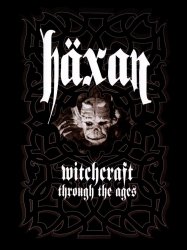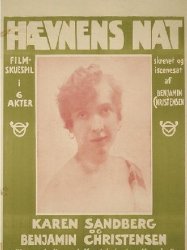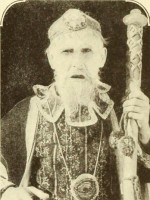Benjamin Christensen is a Actor, Director, Scriptwriter, Producer, Editor and Production Design Danois born on 28 september 1879 at Viborg (Danemark)

Benjamin Christensen (28 September 1879 – 2 April 1959) was a Danish film director, screenwriter and an actor both in film and on the stage. As a director he is most well known for the 1922 film Häxan and as an actor, he is best known for his performance in the film Michael (1924), in which he plays Claude Zoret, the jilted lover of the film's title character.
In 1913, Christensen assumed control of the small, Hellborg-based production company for which he worked and reorganized it as Dansk-Biograf Kompagnie. The first film he directed, Det hemmelighedsfulde X (The Mysterious X, 1914), was one of the most astonishing directorial debuts in film history; although a routine spy melodrama, the camerawork, cutting and art direction were revolutionary for the period. Christensen himself played the main role, as he did in his second film, Hævnens nat (Blind Justice, 1916). Once again, Christensen portrayed a man wrongly accused of murder, and the artistic quality of his sophomore effort was equal to his first. Despite the success of his first two films, Christensen did not find acceptance within the Danish film industry, and after Blind Justice he returned to the stage.
Between 1918 and 1921, Christensen researched the history of necromancy as background for his next and greatest film, Häxan (The Witches, or Witchcraft Through the Ages, 1922), in which Christensen appeared in the role of Satan. A plotless panorama of the history of witchcraft, Häxan is a visual tour de force that utilizes nudity, gore and sheer shock value on a level that remains incredible for a silent film; nevertheless, despite being plundered by censor boards everywhere, Häxan was an international success. Based on the response to Häxan, Christensen received an invitation from UFA to direct in Germany. He made two films for them, though Christensen's most memorable work in Germany was as an actor in the key supporting role of the painter Claude Zoret in his fellow countryman Carl Theodor Dreyer's film Michael (1924). This would prove Christensen's last film appearance as an actor.
In 1924, M-G-M swept through the talent pool at UFA and picked up, among others, Christensen, who departed so quickly that he may not have completed his second feature, Die Frau mit dem schlechten Ruf (The Woman of Ill-Repute, 1925); it wasn't released until the end of 1925 and by that time Christensen had already disowned it. Christensen got off a good start with the Norma Shearer vehicle The Devil's Circus (1926), a commercial success. But the Lon Chaney picture Mockery (1927) which followed was a scandalous failure critically, even as it still generated a modest profit. When work stalled in 1927 on M-G-M's troubled, three-years-long production of The Mysterious Island (1929), Christensen was let go. He moved to Warner Brothers, where he made four films; the first was The Hawk's Nest (1928), a crime drama starring Milton Sills. The remaining three constitute a horror trilogy and were co-written with Cornell Woolrich; The Haunted House (1928), Seven Footprints to Satan (1929) and House of Horror (1929). By this time, Christensen had had enough of his Hollywood experience and although House of Horror was a hit, after it wrapped he went back to Denmark.
Afterward, Christensen returned once again to stage direction and did not make another film for a decade. Breaking his silence, for the Nordisk Company he wrote and directed Skilsmissens børn (Children of Divorce, 1939), a social melodrama about the generation gap; it was a surprise hit, and Christensen seemed back on track again. He followed it with Barnet (The Child, 1940) – a film about abortion – and Gå med mig hjem (Come Home with Me, 1941) which reunited him with actress Bodil Ipsen, who had appeared alongside Christensen in the Bjørnson film and was herself a director. However, Damen med de lyse Handsker (The Lady with the Light Gloves, 1942) was a spy thriller that proved an unmitigated disaster on the level of Mockery, and Christensen found himself out of the film business for good. Afterward, he assumed management of a movie theater in a suburb of Copenhagen and lived out the rest of his 79 years in obscurity.
Source : Wikidata
Benjamin Christensen

- Infos
- Photos
- Best films
- Family
- Characters
- Awards
Nationality Danemark
Birth 28 september 1879 at Viborg (Danemark)
Death 2 april 1959 (at 79 years) at Copenhagen (Danemark)
Birth 28 september 1879 at Viborg (Danemark)
Death 2 april 1959 (at 79 years) at Copenhagen (Danemark)
Benjamin Christensen (28 September 1879 – 2 April 1959) was a Danish film director, screenwriter and an actor both in film and on the stage. As a director he is most well known for the 1922 film Häxan and as an actor, he is best known for his performance in the film Michael (1924), in which he plays Claude Zoret, the jilted lover of the film's title character.
Biography
Benjamin Christensen was born in Viborg and initially studied medicine, but caught the acting bug and began studies at the Det Kongelige Teater (Royal Danish Theatre) in Copenhagen in 1901. Christensen's professional acting career began in Aarhus in 1907, but after a short stint as actor he abandoned the stage in order to become a wine salesman. In 1911, Christensen made his debut as a film actor; all of his pre-directorial efforts are lost, but among such films was Scenens børn (1913), the only motion picture directed by eminent Norwegian playwright and stage director Bjørn Bjørnson.In 1913, Christensen assumed control of the small, Hellborg-based production company for which he worked and reorganized it as Dansk-Biograf Kompagnie. The first film he directed, Det hemmelighedsfulde X (The Mysterious X, 1914), was one of the most astonishing directorial debuts in film history; although a routine spy melodrama, the camerawork, cutting and art direction were revolutionary for the period. Christensen himself played the main role, as he did in his second film, Hævnens nat (Blind Justice, 1916). Once again, Christensen portrayed a man wrongly accused of murder, and the artistic quality of his sophomore effort was equal to his first. Despite the success of his first two films, Christensen did not find acceptance within the Danish film industry, and after Blind Justice he returned to the stage.
Between 1918 and 1921, Christensen researched the history of necromancy as background for his next and greatest film, Häxan (The Witches, or Witchcraft Through the Ages, 1922), in which Christensen appeared in the role of Satan. A plotless panorama of the history of witchcraft, Häxan is a visual tour de force that utilizes nudity, gore and sheer shock value on a level that remains incredible for a silent film; nevertheless, despite being plundered by censor boards everywhere, Häxan was an international success. Based on the response to Häxan, Christensen received an invitation from UFA to direct in Germany. He made two films for them, though Christensen's most memorable work in Germany was as an actor in the key supporting role of the painter Claude Zoret in his fellow countryman Carl Theodor Dreyer's film Michael (1924). This would prove Christensen's last film appearance as an actor.
In 1924, M-G-M swept through the talent pool at UFA and picked up, among others, Christensen, who departed so quickly that he may not have completed his second feature, Die Frau mit dem schlechten Ruf (The Woman of Ill-Repute, 1925); it wasn't released until the end of 1925 and by that time Christensen had already disowned it. Christensen got off a good start with the Norma Shearer vehicle The Devil's Circus (1926), a commercial success. But the Lon Chaney picture Mockery (1927) which followed was a scandalous failure critically, even as it still generated a modest profit. When work stalled in 1927 on M-G-M's troubled, three-years-long production of The Mysterious Island (1929), Christensen was let go. He moved to Warner Brothers, where he made four films; the first was The Hawk's Nest (1928), a crime drama starring Milton Sills. The remaining three constitute a horror trilogy and were co-written with Cornell Woolrich; The Haunted House (1928), Seven Footprints to Satan (1929) and House of Horror (1929). By this time, Christensen had had enough of his Hollywood experience and although House of Horror was a hit, after it wrapped he went back to Denmark.
Afterward, Christensen returned once again to stage direction and did not make another film for a decade. Breaking his silence, for the Nordisk Company he wrote and directed Skilsmissens børn (Children of Divorce, 1939), a social melodrama about the generation gap; it was a surprise hit, and Christensen seemed back on track again. He followed it with Barnet (The Child, 1940) – a film about abortion – and Gå med mig hjem (Come Home with Me, 1941) which reunited him with actress Bodil Ipsen, who had appeared alongside Christensen in the Bjørnson film and was herself a director. However, Damen med de lyse Handsker (The Lady with the Light Gloves, 1942) was a spy thriller that proved an unmitigated disaster on the level of Mockery, and Christensen found himself out of the film business for good. Afterward, he assumed management of a movie theater in a suburb of Copenhagen and lived out the rest of his 79 years in obscurity.
Usually with
Filmography of Benjamin Christensen (17 films)
Actor

Michael (1924)
Directed by Carl Theodor Dreyer
Origin German
Genres Drama, Romance
Themes Peinture, Films about sexuality, LGBT-related films, LGBT-related films, LGBT-related film
Actors Benjamin Christensen, Walter Slezak, Nora Gregor, Alexander Murski, Grete Mosheim, Karl Freund
Roles Claude Zoret
Rating70%





A famous painter named Claude Zoret falls in love with one of his models, Michael, and for a time the two live happily as partners. Zoret is considerably older than Michael, and as they age, Michael begins to drift from him, although Zoret is completely blind to this. When a bankrupt countess comes to Zoret to have a portrait made — with the real intent of seducing him and swindling his money — she finds Michael to be more receptive to her advances. At her lead, the two quickly become a couple and she immediately begins using Michael to steal from Zoret. When Zoret discovers what has been going on, he is crushed and his work suffers terribly.

Häxan (1922)
, 1h27Directed by Benjamin Christensen
Origin Danemark
Genres Drama, Documentary, Fantasy, Horror, Historical
Themes Films about magic and magicians, Medical-themed films, Films about religion, Films about sexuality, Erotic films, Sexploitation films, Demons in film, Witches in film, Films about psychiatry, Nonnesploitation
Actors Clara Pontoppidan, Oscar Stribolt, Benjamin Christensen, Elith Pio, Astrid Holm, Tora Teje
Roles Devil
Rating75%





A scholarly dissertation on the appearances of demons and witches in primitive and medieval culture, a number of photographs of statuary, paintings, and woodcuts are used as demonstrative pieces. In addition, several large scale models are employed to demonstrate medieval concepts of the structure of the solar system and the commonly accepted depiction of Hell.

Blind Justice (1916)
, 1h40Directed by Benjamin Christensen
Origin Danemark
Genres Drama, Thriller, Horror, Crime
Actors Benjamin Christensen, Jon Iversen, Charles Wilken, Mathilde Nielsen, Elith Pio, Osvald Helmuth
Roles "Strong" Henry/John
Rating66%





La veille du Nouvel An, le meurtrier Strong Henry s'évade de prison et va chercher son fils à l'orphelinat. Lorsqu'il s'introduit dans un manoir local pour y chercher du lait pour son enfant, il est surpris par une jeune femme, Eva. Par pitié, elle décide d'aider l'étranger, mais malheureusement, les autres occupants du manoir se réveillent et appellent la police. Quatorze ans plus tard, Henry sort de prison. Convaincu qu'Eva l'a trahi, il entreprend de se venger et de retrouver son fils.

The Mysterious X (1914)
, 1h24Directed by Benjamin Christensen
Origin Danemark
Genres Drama
Themes Spy films
Actors Benjamin Christensen, Bjørn Spiro, Svend Rindom, Robert Schmidt
Roles Lieutenant van Hauen
Rating67%





Un officier de marine est accusé à tort d'espionnage, et celui qui l'a fait accuser tente de faire chanter sa femme.
Director

Lady with the Light Gloves (1942)
, 1h21Directed by Benjamin Christensen
Origin Danemark
Genres Drama
Actors Lily Weiding, Hans-Henrik Krause, Karl Jørgensen, Jessie Rindom, Olaf Ussing, Bjarne Henning-Jensen
Rating49%






Come Home With Me (1941)
, 1h30Directed by Benjamin Christensen
Origin Danemark
Genres Drama
Actors Bodil Ipsen, Johannes Meyer, Grethe Holmer, Eigil Reimers, Mogens Wieth, Helga Frier
Rating31%






The Child (1940)
, 1h25Directed by Benjamin Christensen
Origin Danemark
Genres Drama, Comedy
Actors Bjarne Forchhammer, Beatrice Bonnesen, Mogens Wieth, Inger Lassen, Gunnar Lauring, Helga Frier
Rating61%






Children of Divorce (1939)
, 1h31Directed by Benjamin Christensen
Origin Danemark
Genres Drama
Actors Grethe Holmer, Johannes Meyer, Mathilde Nielsen, Johannes Meyer, Jeanne Darville, Carlo Wieth
Rating33%






The Mysterious Island (1929)
, 1h35Directed by Benjamin Christensen, Maurice Tourneur, Lucien Hubbard
Origin USA
Genres Drama, Science fiction, Fantasy, Action, Adventure, Horror, Romance
Themes Seafaring films, Transport films, Underwater action films, Submarine films, Pirate films, Films based on science fiction novels, Political films
Actors Lionel Barrymore, Jacqueline Gadsden, Montagu Love, Lloyd Hughes, Harry Gribbon, Snitz Edwards
Rating60%





On a volcanic island near the kingdom of Hetvia rules Count Dakkar, a benevolent leader and scientist who has eliminated class distinction among the island's inhabitants. Dakkar, his daughter Sonia and her fiance, engineer Nicolai Roget have designed a submarine which Roget pilots on its initial voyage just before the island is overrun by Baron Falon, despotic ruler of Hetvia. Falon sets out after Roget in a second submarine and the two craft, diving to the ocean's floor, discover a strange land populated by dragons, giant squid and an eerie undiscovered humanoid race.

Seven Footprints to Satan (1929)
, 1hDirected by Benjamin Christensen
Origin USA
Genres Comedy, Comedy-drama, Horror comedy, Horror, Crime
Themes Ghost films, Comedy horror films
Actors Thelma Todd, Creighton Hale, William V. Mong, Sheldon Lewis, Sōjin Kamiyama, DeWitt Jennings
Rating65%





Jim and Eve, a young society couple, are kidnapped on the eve of Jim's departure for Africa and brought to a mansion that is home to a strange and glamorous Satanic cult.

House of Horror (1929)
, 1h5Directed by Benjamin Christensen
Origin USA
Genres Comedy, Horror comedy, Horror
Themes Comedy horror films
Actors Louise Fazenda, Chester Conklin, Thelma Todd, William V. Mong, Émile Chautard, William Orlamond
Rating61%






The Hawk's Nest (1928)
Directed by Benjamin Christensen
Origin USA
Genres Drama
Actors Milton Sills, Doris Kenyon, Sōjin Kamiyama, Montagu Love, Mitchell Lewis, Stuart Holmes
The title of The Hawk's Nest comes from the speakeasy around which most of the action revolves. Two bootleggers, played by Milton Sills and Mitchell Lewis, quarrel over a dancer (Doris Kenyon) while a political assassination plot.

The Haunted House (1928)
, 1h10Directed by Benjamin Christensen
Origin USA
Genres Drama, Comedy, Comedy-drama, Horror
Themes Films based on plays
Actors Larry Kent, Thelma Todd, Edmund Breese, Sidney Bracey, Barbara Bedford, Flora Finch
Rating66%






Mockery (1927)
, 1h15Directed by Benjamin Christensen
Origin USA
Genres Drama, Romance
Themes Political films
Actors Lon Chaney, Barbara Bedford, Ricardo Cortez, Emily Fitzroy, Mack Swain, John Mack Brown
Rating67%






The Devil's Circus (1926)
, 1h10Directed by Benjamin Christensen
Origin USA
Genres Drama
Themes Circus films, Films about religion, Demons in film
Actors Norma Shearer, Charles Emmett Mack, Carmel Myers, John Miljan, Claire McDowell, Charles Murray
Rating65%





Mary and Carlstop are a trapeze artist and a pickpocket who get themselves almost fatally involved with Lieberkind, a lion-tamer, and his jealous wife Yonna.
 Connection
Connection




